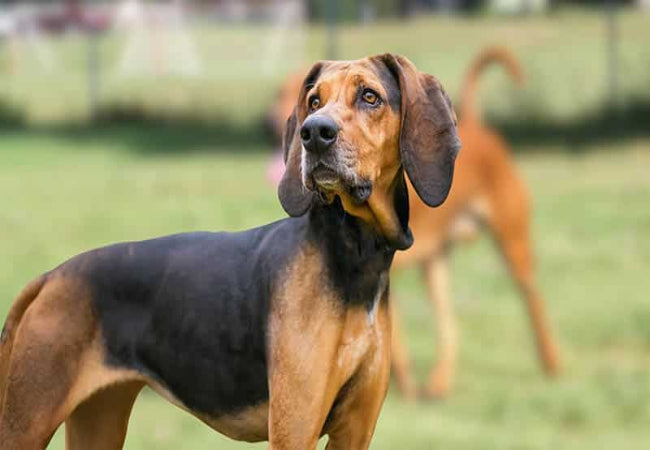American English Coonhound: The Scent-Hunting Companion🐶✨

In this article
American English Coonhound: The Scent-Hunting Companion🐶✨
By Dr. Duncan Houston BVSc
The American English Coonhound—also known as the English Coonhound or Redtick—is bred for nighttime tracking and treeing prey with a powerful bay. These medium-large hounds are loyal, energetic, and deeply driven by scent. As both a working dog and beloved family companion, they thrive under structured care and purposeful guidance.
📜 Origins & Breed Characteristics
- Heritage: Descended from English foxhounds, formally recognized by the UKC in 1905 and the AKC in 2011.
- Height & Weight: 23–26" tall, 40–65 lb—lean and muscular with impressive endurance.
- Coat: Short, dense, coarse—comes in redtick, bluetick, tricolor, and patterns.
- Temperament: Friendly and sociable, but scent‑driven, vocal, and independent-seeking—requires consistent training and socialization.
- Life Expectancy: Typically 11–12 years.
🏡 Living Environment & Exercise Needs
These dogs aren’t couch potatoes:
- Require 60–120 minutes of daily exercise—walks, scent trails, lure coursing, or fieldwork to stay satisfied.
- Not well-suited to apartment life unless heavily exercised—ideally a securely fenced yard to manage prey drive.
- Highly vocal; baying is instinctual when tracking. Great watchdogs, but need voice-control training.
Ask A Vet Tip:
Log exercise sessions and vocal episodes in the app to see trends and get personalized training tips from real vets.
✂️ Coat Care & Grooming
Very manageable coat maintenance:
- Weekly brushing with a mitt or rubber brush to manage shedding.
- Shampoo only when dirty—hounds have natural "doggy odor" from tracking.
- Routine hygiene—clean ears frequently (droopy ears trap debris), trim nails, and brush teeth.
Ask A Vet Tip:
Use grooming reminders and photo logs to track coat condition, ear health, and skin changes over time.
🍽️ Nutrition & Feeding Recommendations
- Feed high-quality adult large-breed kibble—typically 2–3 cups daily, in 2 meals.
- Use slow-feed bowls and avoid vigorous exercise around mealtime to reduce bloat risk.
- Provide continuous access to fresh water—comes from heavy outdoor activity.
- Ask about supplements: omega-3s for coat and joints, probiotics for digestive health.
Ask A Vet Tip:
Track weight monthly to prevent obesity. The app will flag trends and suggest adjustments or vet follow-up.
🩺 Breed-Specific Health Considerations
Generally healthy, but be mindful of:
- Hip/elbow dysplasia: Screen early—manage weight, exercise, and consider joint supplements.
- Ear infections: Result from flappy ears—clean and monitor regularly.
- Bloat/GDV: Deep-chested breeds are vulnerable—preventive feeding strategies needed.
- Hypothyroidism: Monitor weight changes and skin quality; annual blood screening.
- Progressive Retinal Atrophy (PRA): Vision loss—look out for night blindness and eye exams.
- Coonhound Paralysis: Rare immune reaction after handling raccoons—watch for weakness in extremities.
Ask A Vet Tip:
Use the app to set reminders for annual screenings (bloodwork, hips, eyes), vaccination boosters, and ear checks following scenting trips.
🎓 Training & Behavior Management
Train with respect and structure:
- Begin socialization before 16 weeks—introduce people, dogs, environments
- Use reward-based training: treats, praise, and Woopf interactive toys
- Short, consistent sessions—hound breeds can be easily distracted by scent
- Teach voice cues to manage baying—balance hunt instincts with home etiquette
- Practice recall in safely fenced areas—always controlled.
Ask A Vet Tip:
Log training sessions and behavior notes. Your vet can suggest specific reinforcement strategies based on temperament logs.
🐕 Suitable Owners & Home Setup
✅ Ideal for:
- Active households—those who love hiking, hunting, or outdoor exercise
- Experience with scent hounds or high-energy breeds
- Homes with secure yards and patient training routines
❌ Not a great fit for:
- Apartment living or limited exercise access
- Families unprepared for vocal, roaming, or prey-driven behaviors
- Homes with small pets without early socialization.
📱 How Ask A Vet Enhances Coonhound Care
- Ask A Vet: Track exercise, baying episodes, vet appointments, and health logs all in one place.
⭐ Case Study – "Hunter’s Second Chance"
Hunter, a 3-year-old English Coonhound, had separation anxiety and loud night baying. By using Ask A Vet, his owner logged nightly vocalization patterns. We introduced:
- Evening mental exercise before downtime
- Positive reinforcement for quiet periods
Within two weeks, night baying decreased by 70%, Hunter slept more calmly, and family stress eased.
🧑⚕️ Final Thoughts from Dr Duncan Houston
The American English Coonhound is a passionate, intelligent companion—perfect for owners who understand their scent-driven nature and need for purpose. By combining structured exercise, grooming, proactive screening, and tools like Ask A Vet, you can build a rewarding relationship rooted in trust and mutual enjoyment.
Recommended next steps: schedule your pup’s first weight check, hip and eye exam, and voice training session using the app. Want another breed guide next time? Just send over the PetMD link!






